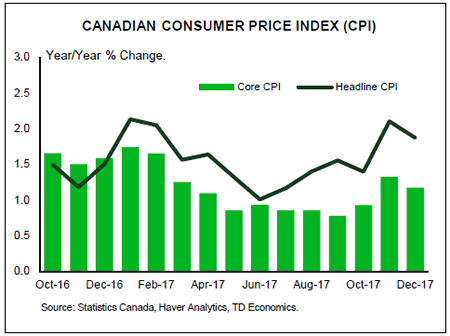U.S. Highlights
- Last week’s market sell-off came to a halt this week. U.S. equities staged a decent recovery, looking past January reports that pointed to higher-than-expected inflation and worse-than-expected retail sales.
- Price gains in the CPI report were broad-based, with core inflation rising by a hearty 0.3% m/m. Unfavorable base-year effects anchored the core pace at 1.8% in y/y terms, but this dynamic should turn more favorable in the months ahead.
- Despite a pullback in retail sales, Q1 consumer spending is still tracking a decent 2% (ann.). This pegs our tracking for Q1 GDP growth above 2%. Decent economic momentum and rising inflation bolster the case for a March hike.
Canadian Highlights
- After last week’s market turmoil, the TSX is set to close up more than 2.0% this week, joining the global recovery in risk assets.
- With the OSFI B-20 guideline in full-effect in January, we anticipated that activity would weaken. And weaken it did, with sales falling 14.5% on a month-on-month basis. However, an outsized collapse in new listings in many markets helped prevent a similar decline in prices.
- Overall, the data this week does little to affect our view that the Bank of Canada is likely to raise rates this July. This should give the Bank enough time to evaluate how higher interest rates are affecting the Canadian economy.
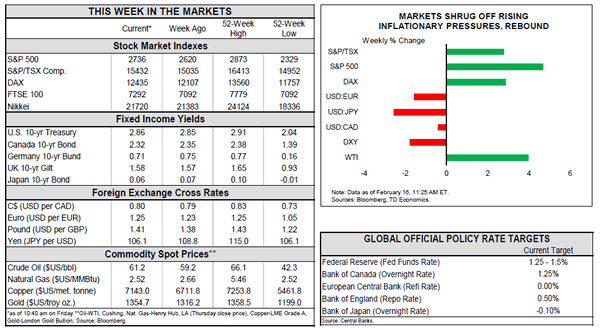
U.S. – Inflation Heats Up on Valentine’s Day
Last week’s equity and bond sell-off halted this week as risk sentiment made a comeback and volatility receded. The much-awaited Valentine’s Day reports failed to deliver as retail sales sharply disappointed while prices rose more than expected. The inflation report pushed Treasury yields higher, with the 10-year rising to a 4-year high. Inflation hedging benefited gold, but the trade-weighted US dollar pulled lower on strengthening global growth and expectation of higher U.S. deficits. Overall, the rebound in equities continued unperturbed (Chart 1).
After the wage-data inspired sell-off, it was encouraging to see that markets took the CPI report in stride. Headline CPI jumped a hefty 0.5% m/m in January (2.1% y/y), boosted by a sharp gain in energy prices. But it wasn’t all energy, with price gains broad-based. In fact, core inflation also rose by a robust 0.3% m/m. While base-year effects anchored the core pace at 1.8% in y/y terms, this dynamic should turn more favorable in the months ahead. In fact, even small monthly gains could take core CPI above target in the coming months. Ultimately, inflation should continue to firm, with this narrative reinforced by a robust gain of 0.4% in the January producer price index, along with a higher share of small businesses raising (and planning to raise) worker compensation (Chart 2). .
Future wage gains will be essential in sustaining the momentum in consumer spending. This is particularly important after a disappointing couple of months. Retail sales not only declined by 0.3% in January, but December’s value was also revised down, wiping out the 0.4% advance estimate. Having said that, last month’s print was weighed down by autos and building materials – categories which may be retreating after receiving a boost in the aftermath of hurricanes Harvey and Irma. Coupled with good performance in the many discretionary spending categories, this indicates that the pullback is likely transitory. All told, the recent developments suggest that first quarter consumer spending is now tracking 2% (ann.) – providing slightly less support to growth than previously anticipated.
The boost from residential investment is also looking increasingly frail at the beginning of 2018. While housing starts picked up to just below their post-recession high in January, the concentration in lower value-added apartments and condos has reduced its overall GDP boost. Despite these developments, first quarter GDP is still tracking above 2% – a number that is enough to reduce economic clack. The consumer and housing sectors are likely to remain supported by a continually improving labor market, despite some headwinds ahead related to recent policy changes and rising rates. Housing should also benefit from tight inventories of existing homes for sale, with the near-term trend supported by permitting activity which reached a new post-recession high.
All in all, economic momentum remains decent and price pressures are rising – both themes that lend support for a March rate hike. Moreover, the risk that possible signs of ‘overheating’ may compel the Fed to step with a more rapid pace of hikes – a move that could stress vulnerabilities in sub-sectors of household and corporate credit – remains well in place.

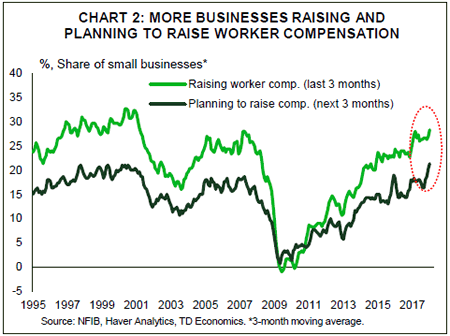
Canada – B-20 Guideline Serves First Body Blow to Home Sales
The reemergence of volatility has breathed some life back into financial markets. After last week’s turmoil, Canada joined in the global recovery in risk assets this week. The TSX is likely to close at least 2.0% higher, but is still about 1000 points (or 6%) below its all-time high achieved this past January. The loonie is roughly unchanged on the week, as U.S. dollar weakness coincided with a higher price of WTI oil but a slight dip in what Canadian producers receive for their heavier blends.
Macroeconomic fundamentals remain solid for Canada. The Canadian economy is expected to have advanced at an above-trend, 2.0% annualized pace in the fourth quarter, and the bits of indicator data reported so far don’t suggest a material slowdown occurring this quarter. Although this morning’s manufacturing sales disappointed expectations in December, the weakness came after an automotive-driven surge in November. Looking ahead, we anticipate that December was likely a blip, and that manufacturing sales will be supportive of Canadian economic activity at the start of 2018.
The most critical piece of data we received this week was on existing home sales. With the OSFI B-20 mortgage guideline in full-effect in January, we anticipated that activity would weaken. And weaken it did, with sales falling 14.5% on a month-on-month (m/m) basis, and only five of twenty-six markets rising. Unsurprisingly, high priced markets such as Ontario’s Greater Golden Horseshoe experienced double-digit declines, as did large markets in Western Canada (Chart 1). But, new listings also fell dramatically in many markets, as sellers, perhaps on the advice of their agents, decided against listing their home for sale in January. This collapse in listings may have helped support prices, which fell a modest 2.4% m/m nationally, led lower by declines in Ontario and B.C..
Although it’s still too early to accurately assess what impact the new B-20 guideline has had on housing markets, the weak January data adds credence to the view that 2017 year-end sales strength was likely due to some pulling forward, as buyers rushed to mortgage up before the New Year.
Looking ahead, we expect near-term volatility to persist as buyers react to the fallout from both the new guideline and rising mortgage rates. After stabilizing mid-year, home sales and prices are likely to remain weighed down by rising interest rates. But, with markets largely in balanced territory, prices should remain well supported.
Overall, the data this week does little to affect our view on the Bank of Canada. The impacts of both the new mortgage guideline and higher mortgage rates have largely been included in its economic forecasts. Moreover, uncertainty lingering over the future of NAFTA dampens any view that stronger U.S. demand may have a substantial, positive impact on Canadian activity in the next couple of years. And, with households more sensitive than ever to rising interest rates, the Bank will likely wait to see inflationary pressures build further before concluding that’s it safe to raise rates again likely this July.
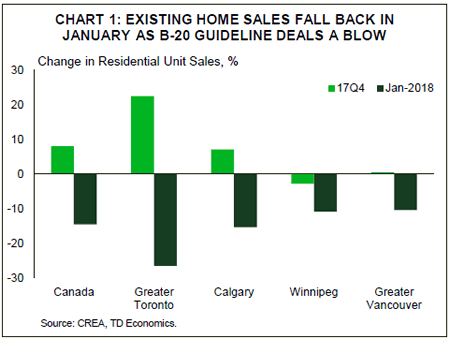
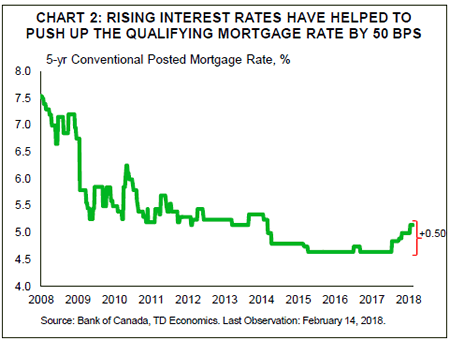
Canada: Upcoming Key Economic Releases
Canadian Retail Sales – December
Release Date: February 22, 2018
Previous Result: 0.2% m/m, 1.6% m/m
TD Forecast: 0.0% m/m, ex-autos: 0.2% m/m
Consensus: N/A
Canadian retailers should end 2017 on a relatively soft note owing to a cold snap of winter weather and a pullback in motor vehicle sales. We expect retail sales to come in flat while ex-auto sales should post a 0.2% increase. After a strong performance in 2017, industry reports suggest motor-vehicles spending should continue cooling to a more sustainable pace and level as consumers turn more cautious on debt-financed, big-ticket items. Gasoline sales should make a positive contribution due to higher prices. Meanwhile, unseasonably cold weather should hold back holiday spending. We also expect sales of electronics to unwind most of November’s 12.9% gain, which was caused by the iPhone X release outside of the regular product launch schedule (typically September). We expect real Retail sales to decline modestly on higher seasonally adjusted consumer prices, though volumes should still post a 4.3% increase in Q4. After a soft Q3, this should allow for a stronger contribution to growth from household spending on goods.
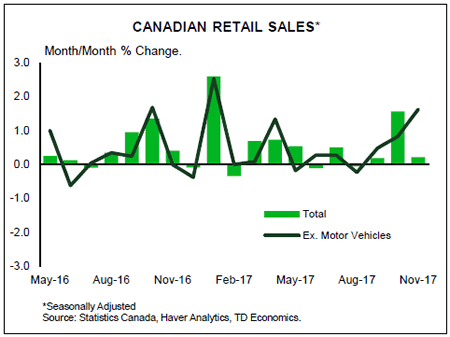
Canadian Consumer Price Index – January
Release Date: February 23, 2018
Previous Result: -0.4% m/m
TD Forecast: 0.6% m/m
Consensus: N/A
We expect headline CPI to pull back to 1.6% y/y, but m/m CPI should rise 0.6% m/m on higher energy prices. Headline CPI is coming off a strong base effect as prices surged 0.9% m/m last January. The jump was mostly driven by energy prices, thanks to carbon taxation and cap-and-trade plans which boosted natural gas and gasoline prices in Alberta, Ontario and Quebec. Adjustments to carbon pricing plans will be more modest this year, which implies a smaller lift to energy prices.
Outside of energy, we expect the momentum in core prices to be stable after rising steadily since last summer. The peak in new-home inflation should mute the cyclical tailwind form shelter prices, although mortgage interest costs are rising thanks to three rate hikes in six months months. A recent area of weakness has been cellphone services where prices crashed 7.6% m/m in December. Although competition has lately intensified in that sector, we expect to be near the bottom in January. We see food prices remaining a key inflation tailwind as the pricing power of grocers has improved since a year ago. Finally, we don’t expect CAD fluctuations to be a significant driver of the price action this month.
